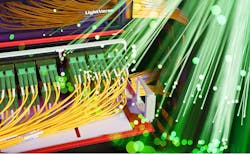Short-Reach Singlemode Reduces Cost Yet Demands Ultra-Low Loss, High Performance Connectivity
Cost-effectively supporting higher-speed applications to distances beyond 100 meters is now feasible with new 100, 200, and 400 Gig short-reach singlemode applications that use power-conserving lasers. However, the relaxed specifications of these applications come with stringent insertion loss budgets and new return loss considerations that demand ultra-low loss, high-performance singlemode cabling systems.
Cutting Costs and Extending Distances
With less power and associated energy consumption and heat generation, power-conserving lasers used for short-reach singlemode applications are significantly less expensive than long-distance singlemode lasers. While preliminary options for these applications were based on non-return-to-zero (NRZ) signaling schemes with a 25 Gig per lane bit rate, the development of the four-level pulse amplitude modulation (PAM4) signaling scheme that enables 50 and 100 Gig per lane bit rates paved the way for the IEEE to introduce data center reach (DR) and fiber reach (FR) singlemode applications with distances of 500 m and 2000 m, respectively. These include 500-meter duplex 100GBASE-DR and parallel optic 200GBASE-DR4 and 400GBASE-DR4 applications and 2000-meter wave division multiplexing (WDM) 200GBASE-FR4 and 400GBASE-FR4 applications.
With short-reach singlemode, the total cost of a 500-meter duplex 100GBASE-DR system now costs less than a 100-meter parallel optic 100GBASE-SR4 multimode system. Due to the cost savings, short-reach DR and FR singlemode applications are expected to rapidly gain ground in enterprise data centers as they migrate to 100, 200, and 400 Gig speeds in backbone switch-to-switch links. They also support cost-effective breakout configurations where a single 200 Gig switch port breaks out to four 50 Gig connections or a single 400 Gig switch port breaks out to four 100 Gig connections, thereby optimizing port utilization and switch density for a reduced cost. The IEEE Beyond 400 Gb/s Ethernet Study group has also included DR and FR applications as part of the physical layer objectives for 800 Gig and 1.6 Terabit applications, which makes these applications also well positioned for cloud and hyperscale data centers that are migrating to 400 and 800 Gig backbone switch-to-switch links and 50, 100, and 200 Gig horizontal switch-to-server links.
Verified Performance Matters
Long-distance singlemode LR and ER fiber applications offer ample insertion loss budgets that can reach 18 dB, but the relaxed specifications for short-reach singlemode applications require far more stringent insertion loss budgets. IEEE standards specify a maximum channel loss of 3 dB for DR applications and 4 dB for FR applications. High-speed short-reach singlemode transceivers are also more susceptible to reflectance, which necessitated IEEE to specify reflectance values for short-reach singlemode applications based on the number of mated pairs in the channel. For example, if the reflectance of mated connectors in a 400GBASE-DR4 application is -45 dB, only four connectors can be included in the channel. With an improved reflectance of -49 dB, 10 connectors can be included. The maximum channel insertion loss is decreased if the discrete reflectance requirements cannot be met.
To ensure sufficient margin to accommodate variables such as poorly installed cabling, contaminated end faces, misalignments, aging transmitters, and other factors, data center designers need to carefully review insertion loss and reflectance specifications for components such as jumpers, trunks, modules, and adapters. In doing to, they should use only verified maximum values and avoid vendors that only publish typical values since typical values are generated primarily for marketing purposes and not guaranteed as a true indication of performance.
Data center designers also need to consider the number of connections in a channel, such as the use of four-connector cross-connect channels that enhance flexibility, management, scalability, and security. Many standard loss systems will not support the tighter loss budgets of short-reach singlemode applications in this configuration, and even some low loss systems will not provide sufficient margin. In fact, third-party testing has demonstrated that only ultra-low loss LC connectors with a verified maximum insertion loss of 0.20 dB and minimum reflectance of -65 dB and ultra-low loss MPO connectors with a verified maximum insertion loss of 0.30 dB and minimum reflectance of -60 dB support the use of cross-connects and provide sufficient channel margin in short-reach DR and FR singlemode deployments.
Gary Bernstein, RCDD, CDCD, is Global Data Center Solutions Specialist at Siemon with more than 20 years of industry experience and extensive knowledge in data center infrastructure. Established in 1903, Siemon is an industry leader specializing in the design the design and manufacture of high quality, high performance IT infrastructure solutions and services for Data Centers, LANs, and Intelligent Buildings.



